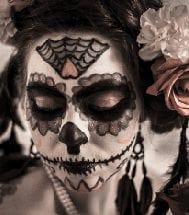
Dia de los Muertos
By Jeri Vigil
October marks the beginning of the holiday season. With the last day of summer passing a few weeks ago it’s time to fall back. Like clockwork, I’m ready to run through the pumpkin patch, get chased by zombies in the corn maze at Christies Ranch in Blue Lake, and start dreaming up a costume for my personal favorite American holiday, Halloween. Besides Sugar Daddies finding their place back in the running next to Kit Kats, Twix, and Whatchamacallits (just kidding those are extinct, whaa), what is the meaning behind this exceptionally morbid, sugar drenched holiday?
As a kid raised in a Hispanic home, we celebrated Halloween as a tradition. Little did I know along with the tricks and treats, my ancestors were getting ready for a visit home. As I got older during the month of October, I started noticing skeletons that weren’t dark, bloody reapers of death. Instead, smiling, colorful men and women, children and animal skeletons were singing and celebrating. The paintings, sculptures, food, and décor pulled at my soul. I knew I needed to dig deeper.
The holiday I fell in love with that is the core of those happy skeletons is known as Dia de los Muertos (Day of the Dead). My heart leapt with joy to learn and bring back a tradition I knew was celebrated in my family’s distant past. I could feel the ancestors sigh of relief as an ancient family tradition would be conjured back to the earthly plane.
Day of the Dead is known to be the most important celebration in Mexico, and is also celebrated throughout various areas of the United States. From the evening of October 31st through November 2nd, family and friends gather to reunite with loved ones past. Traditionally, altars are built with memorabilia, pictures, and offerings of food and drink to the adults, children, and even animals that have moved on. It is believed that during this window of time, or “thinning of the veil,” souls visit from the other side and return home to feast with the family. Tamales and dead bread are often included in the ofrendas (offerings). Colorful sculpted skulls made of sugar known as sugar skulls adorn the celebration. Gravestones decorated with flowers, candles, and traditional meals take over grave yards. The Halloween tradition of lighting candles in the pumpkins stems from helping the souls during this time to find there way home, and then back to the land of the dead.
Dia de los Muertos is a great opportunity to put aside time to share stories, take out old photos, and remember where we came from. It’s a time for healing, reflection, celebration, and letting go. Acknowledging what was, what is, and a way to move the family lineage positively forward. If your family history has been lost, one idea is to create a space to honor your existence and what you find important to be remembered as.
If you’re looking to take part in some local activities, Los Bagels offers an annual dead bread making class. Sign up early, spots go fast. Also, the Multicultural Center at Humboldt State is commemorating this festive holiday from October 31 to November 1 in the Karshner Lounge. If you feel like making a special trip down to The Mission area of San Francisco you will not be disappointed by the various parades, altars, foods, and dances going on.
In terms of good ol’ Halloween-style celebrations , the Zombie Ballet will be put on by the Northcoast Dance Center with various performances in October. Oh, and to answer that earlier question, the meaning of Halloween varies for most, but the lineage of Halloween is linked to the festival of all Christian saints and martyrs known or unknown. It was called All-Hallows or Hallowmass. It is believed that Pope Boniface IV in the seventh century substituted this for a pagan festival of the dead. Now imagine that!



Leave a Reply